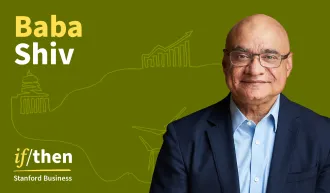Foster a More “Giving” Identity to Rouse Donors and Volunteers
A study looks at the relationship between self-image and charitable giving.
August 01, 2009
Charities and nonprofits are suffering as much as commercial businesses from the economic downturn. Donations at two-thirds of public charities declined between 2007 and 2008, according to the Giving USA Foundation. This represents the first decrease in donations in current dollars since 1987, and only the second in year-by-year giving slump since the organization began publishing its annual reports 52 years ago.
But new research by Jennifer Aaker of Stanford GSB and Satoshi Akutsu of Hitotsubashi University, points to ways nonprofits can reverse this trend. In their paper, “Why Do People Give? The Role of Identity in Giving,” forthcoming in the Journal of Consumer Psychology, Aaker and Akutsu say by encouraging people to adopt a more “giving” identity, nonprofits can affect their willingness to donate money as well as volunteer their time.
An identity — a person’s sense of who they are and how they view themselves — feels stable but is surprisingly malleable. “Really small manipulations can have a really big impact on how people think of themselves,” said Aaker, General Atlantic Professor of Marketing, who has long been interested in what motivates people to give to others — time as well as money — and how giving impacts individuals’ emotional state of mind.
“Does someone think of himself or herself as the kind of person who gives to panhandlers? To friends? Who marches for causes? Under what circumstances do they give — either by volunteering time or donating money?” asked Aaker. “It turns out that someone can have a giving identity only under certain conditions or in certain contexts. So the question for nonprofit organizations is: How can they tap into a person’s giving identity?”
Building on previous identity research by Daphna Oyserman of the University of Michigan, Aaker and Akutsu examined three aspects of giving and identity. First, given identities are malleable, how can nonprofits successfully stimulate them by changing the context in which people are asked for help? For example, if a person’s mother suffered from breast cancer, would asking that person for money or time in their home — as opposed to in their workplace — trigger a more personal response due to a more direct association with their mother, and therefore result in greater giving to that cause?
Second, should nonprofits encourage people to act through triggering social identities — the cohort an individual identifies with — or by evoking more emotional or personal responses? Researchers found people give more money to public radio stations if told that another donor with the same social profile — for example, another female — made a large contribution. “Connecting giving to a social group not only increases the importance of the gift, it changes the meaning of the gift,” said Aaker.
Finally, how can nonprofits achieve greater giving by helping people make better sense of their worlds? In earlier research, Aaker and her colleague, Wendy Liu, UCLA, found that asking people first for time — rather than money — increased the chance they would give money when asked later. However, the reverse appears to be true when social rather than personal identities were evoked. For example, when people are asked “How interested are you in joining others working for HopeLab?” and “How interested are you in joining others donating to HopeLab?” they give more money when first asked for money. In other words, when you give money with friends and family to support a cause — the meaning of that monetary donation changes to become more emotionally meaningful.
And it’s not just that identity affects giving. The reverse is also true. The act of giving, either in kind or in cash — for example, participating in the Avon Walk for Breast Cancer — impacts people’s identities. After taking part in an Avon walk, participants identify themselves as the type of people who give to that cause.
There’s evidence that people just need to be offered the chance to give to do so. In an April 2007 survey by insurance and financial services firm Nationwide, 57 percent said they didn’t plan to volunteer more in the coming year. Forty-eight percent describe themselves as currently not — or not very — involved in their communities. Their biggest reason for not volunteering is not being able to find the right opportunities. By offering such opportunities — and adjusting requests to evoke the right kind of identities — nonprofits can help givers’ emotional well-being as well as themselves.
Looking ahead, Aaker sees a number of areas that need to be investigated further. For example, will people give more when asked simply “Will you help?” or when asked more specific questions such as “Will you give money to the X charity?” or “Will you volunteer for Y cause?”
Another area for study is how people give differently as they age. That people’s emotional goals change as they grow older is well established. “However, it’s still unclear how that impacts their giving,” said Aaker. “Much identity work presumes that your identity remains robust over time. But this more recent research that illustrates how identities are much more dynamic raises interesting questions and has significant ramifications for nonprofits.”
For media inquiries, visit the Newsroom.
Explore More

What Makes Some Words More Memorable Than Others?

To Make Influencers Seem More Authentic, Just Add #Friends



